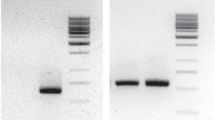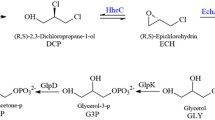Abstract
A toluene-oxidizing strain ofPseudomonas mendocina KR1 containing toluene-4-mono-oxygenase (TMO) completely degrades TCE with the addition of toluene as a co-substrate in aerobic condition. In order to constructin situ bioremediation system for TCE degradation without any growth-stimulating nutrients or toxic inducers such as toluene, we used the carbon-starvation promoter ofPseudomonas putida MK1 (Kim, Y.et al., J. bacteriol., 1995). Upon entry into the stationary phase due to the deprivation of nutrients, this promoter is strongly induced without further cell growth. The TMO gene cluster (4.5 kb) was spliced downstream of the carbon starvation promoter ofPseudomona putida MK1, already cloned in pUC19. TMO under the carbon starvation promoter was not expressed inE. coli cells either in stationary phase or exponential phase. For TMO expression inPseudomonas strains,tmo and carbon starvation promoter region were recloned into a modified broad-host range vector pMMB67HES which was made from pMMB67HE (8.9 kb) by deletion oftac promoter andlacI q (about 1.5 kb). Indigo was produced by TMO under the carbon starvation promoter in aPseudomonas strain of post-exponential phase on M9 (0.2% glucose and 1mM indole) or LB. 18% of TCE was degraded in 14 hours after entering the stationary phase at the initial concentration of 6.6μ M in liquid phase.
Similar content being viewed by others
References
Winter, R. B., K-M. Yen, and B. D. Ensley (1989) Efficient degradation of trichloroethylene by a recombinantE. coli.Bio/Technol. 7: 282–285.
Nelson, M. J. K., S. O. Montgomery, E. J. O’nell, and P. H. Pritchard (1986) Aerobic metabolism of trichloroethylene by a bacterial isolate.J. Bacteriol. 52: 383–384.
Wackett, L. P. and D. T. Gibson (1988) Degradation of trichloroethylene by toluene dioxygenase in whole-cell studies withPseudomonas putida F1.Appl. Environ. Microbiol. 54: 1703–1708.
Matin, A., C. D. Little, C. D. Fraley, and M. Keyhan (1995) Use of starvation promoters to limit growth and selectively express trichloro-ethylene and phenol transformation activity in recombinantE. coli.Appl. Environ. Microbiol. 61: 3323–3328.
Kim, Y.J., P. Ayoubi, and A. R. Harker (1996) Constitutive expression of the cloned phenol hydroxylase gene(s) fromAlcali genes eutrophus JMP134 and concomitant trichloroethylene oxidation.Appl. Environ. Microbiol. 62: 3010–3016.
Ensley, B. D., B. J. Ratzkin, T. D. Osslund, M. J. Simon, L. P. Wackett, and D. T. Gibson (1983) Expression of naphthalene oxidation genes inEscherichia coli results in the biosynthesis of indigo.Science 222: 167–169.
Gossett, J. M. (1987) Measurement of Henry’s law constants for C1 and C2 chlorinated hydrocarbons.Environ. Sci. Technol. 21: 202–208.
Foerste, J. P., W. Pansegrau, R. Frank, H. Bloecker, P. Scholz, M. Bagdasarian, and E. Lanka (1986) Molecular cloning of the plasmid RP4 primase region in a multi-host rangetacP expression vector.Gene 48: 119–131.
Davison, J., F. Brunel, K. Kaniga, and N. Chevalier (1990) Recombinant DNA vectors for Pseudomonas In:Pseudomonas; Biotransformation, Pathogenesis, and Evolving Biotechnology (Silver, S., Chakrabarty, A.M., Iglewski, B., and Kaplan S.) Ch.24, pp. 242–251. American Society for Microbiology, Washington, D.C.
Kim, Y. J., L. S. Watrud, and A. Matin (1995) A carbon starvation survival gene ofPseudomonas putida is regulated by a54.J. Bacteriol. 177: 1850–1859.
Luo, J., G. Burns, and J. R. Sokatch (1993) Construction of chromosomalrecA mutants ofPseudomonas PpG2.Gene 136: 263–266.
Mot, R. D., T. Laeremans, G. Schoofs, and J. Vanderleyden (1993) Characterization of the recA gene fromPseudomonas fluorescens OE 28.3 and construction ofrecA mutant.J. Gen. Microbiol. 139: 49–57.
Mcclay, K., S. H. Streger, and R. J. Steffan (1995) Induction of toluene oxidation activity inPseudomonas mendocina KR1 andPseudomonas sp. strain ENVPC5 by chlorinated solvents and alkanes.Appl. Environ. Microbiol. 61: 3479–3481.
Yen, K-M., and M. R. Karl (1992) Identification of a new gene,tmoF, in thePseudomonas mendocina KR1 gene cluster encoding toluene-4-monooxygenase.J. bacteriol. 174: 7253–7261.
Author information
Authors and Affiliations
Corresponding author
Rights and permissions
About this article
Cite this article
Hahm, D.H. Degradation of trichloroethylene by a growth-arrestedPseudomonas putida . Biotechnol. Bioprocess Eng. 3, 11–14 (1998). https://doi.org/10.1007/BF02932476
Issue Date:
DOI: https://doi.org/10.1007/BF02932476




